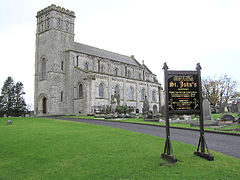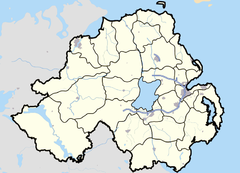- Moneymore
-
- Moneymore is also the name of a farming district near Milton, New Zealand.
- Moneymore is also the name of a large housing estate in Drogheda, Ireland.
Coordinates: 54°41′31″N 6°40′12″W / 54.692°N 6.670°W
Moneymore Irish: Muine Mór 
St John's Desertlynn Church of Ireland, in Moneymore
 Moneymore shown within Northern Ireland
Moneymore shown within Northern IrelandPopulation 1,369 (2001 Census) Irish grid reference H8583 District Cookstown County County Londonderry Country Northern Ireland Sovereign state United Kingdom Post town MAGHERAFELT Postcode district BT45 Dialling code 028 Police Northern Ireland Fire Northern Ireland Ambulance Northern Ireland EU Parliament Northern Ireland UK Parliament Mid Ulster NI Assembly Mid Ulster List of places: UK • Northern Ireland • County Londonderry Moneymore (from Irish: Muine Mór, meaning "large thicket or large hill")[1] is a village in County Londonderry, Northern Ireland. It had a population of 1,369 in the 2001 Census.
It is an example of a Plantation village in Mid-Ulster. It was the first town in Ulster to have piped water.
Contents
Geography
Moneymore lies in a glen. The Ballymully River flows through the southern part of the village. The river rises on a large hill, Slieve Gallion (one of the Sperrins), which has a radio tower on top. The village is about 35 miles from the sea to the north.
History
Originally built by the Worshipful Company of Drapers, the village was held in such esteem that they invested in a large scale reconstruction during 1817. During The Troubles, seven people were killed in or near Moneymore in violence related to the conflict, six of them by the Provisional IRA.
See also: The Troubles in MoneymorePeople
- Walter Greer is a member of the Ulster Unionist Party. He is a local councillor in Cookstown District Council.
- Suspected serial killer John Bodkin Adams lived in Moneymore for a few years in the first decade of the twentieth century. He became a general practitioner and moved to Eastbourne in 1922. He was charged in 1957 with the murder of two patients but was controversially acquitted. He was, however, suspected of causing the death of 163 other patients.
- Richard William Enraght was an Anglican priest and religious controversialist. He was born in Moneymore on the 23 February 1837, the son of the Reverend Matthew Enraght the Assistant Curate of the parish.[2]
- Brian Weir MBE a relatively famous 21st century explorer, was the first to climb to the summit of Mount Gee, South Australia (2,099 ft). A well known character of dubious nature, who was born and raised on a small farm holding on the outskirts of Moneymore. He now resides in Geneva, Switzerland.
- Author and musician Rodney Orpheus was born and raised in Moneymore.
Places of interest
The most notable building in the town is the 17th century Plantation house, Springhill, built and owned by the Conyngham, later Lenox-Conyngham family but since 1957 in the ownership of the National Trust.
Moneymore Model Village depicts life in rural Ulster at the time of the Plantation.
Transport
- Moneymore railway station opened on 10 November 1856 and shut on 2 May 1955.[3]
Amenities
Moneymore has a surgery which serves villages such as The Loup, Ballyronan and Desertmartin. As well as that, Moneymore has Dalriada Emergency Surgery which is 24/7. It also has a post office, pharmacy, a number of convenience stores, a privately owned bus service, a privately owned crane company, and a privately owned bicycle shop. Until July 2006 there was a Police Service of Northern Ireland (PSNI) station.
Sport
- Moneymore GAC is the local Gaelic Athletic Association club.
Schools
There are two primary schools in Moneymore: Moneymore Primary School (the state primary school) and St. Patrick's Primary School (a Roman Catholic primary school). Most children of secondary school age attend one of the schools in nearby Cookstown or Magherafelt.
Churches
- St. John's Church (Church of Ireland)
- Church of SS John & Trea (Roman Catholic)
- Moneymore First Presbyterian Church
- Moneymore Second Presbyterian Church
- Moneymore Congregational Church
- Moneymore Gospel Hall
2001 Census
Moneymore is classified as a village by the NI Statistics and Research Agency (NISRA) (ie with population between 1,000 and 2,250 people). On Census day (29 April 2001) there were 1,369 people living in Moneymore. Of these:
- 25.0% were aged under 16 years and 16.1% were aged 60 and over
- 45.29% of the population were male and 52.1% were female
- 47.8% were from a Catholic background and 51.0% were from a Protestant background;
- 3.1% of people aged 16–74 were unemployed.
For more details see: NI Neighbourhood Information Service
Trivia
55 Rockview Park, a terraced house in Moneymore, was reportedly haunted. [1]
On Friday 15 February 2008 at 11.00pm a Second World War bombshell was found in the Millrace Manor estate. A number of houses were evacuated and the Mace convenience store was shut for a period of time. The police were called in and the mortar bomb was found incapable of exploding.
See also
External links
- Moneymore and Draperstown: The Architecture and Planning of the Estates of the Drapers Company in Ulster
- Moneymore Market Houses
- Photos of the town taken around 1920
- Moneymore GP
References
- ^ Placenames Database of Ireland
- ^ From the baptismal registers of St John's church Desertlyn
- ^ "Moneymore station" (PDF). Railscot - Irish Railways. http://www.railscot.co.uk/Ireland/Irish_railways.pdf. Retrieved 2007-09-06.
Categories:- Villages in County Londonderry
Wikimedia Foundation. 2010.


